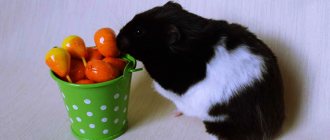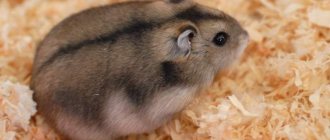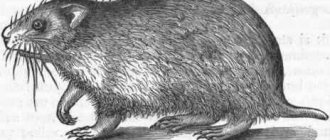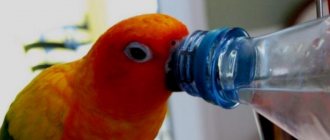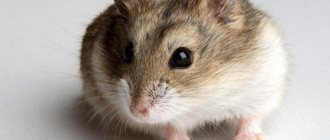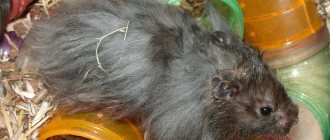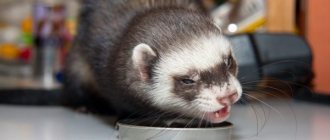With the arrival of summer, more seasonal products appear on our table: different varieties of berries, fresh home-grown vegetables, juicy greens straight from the garden. All of them contain a huge amount of useful substances and microelements. When we consume summer gifts for food, we often think about treating our pets to them. Hamsters, like other rodents, benefit from greens. Therefore, let’s consider whether hamsters can have parsley and dill, and how to serve them correctly.
Composition of parsley
Parsley is a very unpretentious plant, so it can grow in almost any soil. In most countries it is a popular addition to the main dish.
Contains many useful elements:
- B vitamins;
- ascorbic acid;
- folic acid;
- niacin;
- phosphorus;
- sodium;
- calcium and many others.
All these positive qualities have a positive effect on the connective tissues of the body, relieving symptoms of intoxication, and maintaining water-salt balance in the body.
There are two types of parsley: curly and ordinary, but both are equally useful.
What's the result?
Yes, friends, to paraphrase a famous advertising slogan - not every weed is equally beneficial. While I was collecting material for the article, I was also surprised by some facts. It used to be like this: he went out into the yard, picked some grass and put it in a cage. What my dzhungarik liked, he ate, what he didn’t like, he didn’t eat. Accordingly, in the evening I threw it away so that it would not dry out and rot. Naturally, I didn’t give him any nettles, because I wouldn’t voluntarily climb into these thickets with my bare hands. It turns out in vain... Lack of iodine in the body causes problems with the thyroid gland, not only in hamsters, but also in people. Yes, I know about nettle cabbage soup, but sorry, it’s not my thing. Do whatever you want with me. And now I’m thinking... Maybe it’s for nothing that I don’t eat them?
Nothing beautiful is alien to us.
In the wild, how do hamsters distinguish beneficial grass from harmful grass? Trial and error? After all, the hamster itself is the size of a child’s fist. Does he need much? It seems that they are mistaken only once... Or, option No. 2 - during evolution, only those who can calmly digest 90% of everything that is in their habitat have survived.
What do you think of it? Tell me?
Parsley in a hamster's diet
To ensure that all the necessary vitamins are regularly present in the animal’s body, it is necessary to give it greens. Parsley is one of the first candidates to be added to the main diet. It will not only replenish vitamins in the animal’s body, but will also have a positive effect on its digestive organs. In addition, there are special elite foods that consist of a special number of nutrients specifically for hamsters. And their contents definitely include parsley and dill.
Little ones are practically not allergic to such a product, so you can give them parsley without fear. You need to collect good greens; those growing near roadways are not suitable. Before use, you need to wash it well, without separating it from the stem, since all the components of parsley are equally useful.
What grass is recommended to give to hamsters?
Once in the meadow, look around, there will probably be a delicious gift for your pet. Well, returning from the garden without a gift is simply a sin. Hamster treats can be found even in the park if the environmental situation in the city is favorable.
The list of herbs useful for hamsters is quite impressive:
- garden plants (dill, parsley, carrot tops, lettuce and celery);
- weeds and meadow grasses (plantain, knotweed, nettle, dandelion, burdock, wheatgrass, bluegrass, knotweed, wormwood);
- forage grasses (young shoots of oats and wheat, alfalfa and clover);
- leaves of trees (apple tree, birch, cherry, maple, willow, etc.).
Herbs with medicinal effect
Many herbs are not only nutritious, but also medicinal. Little furry babies can have health problems. In this case, you can use medicines from a natural pharmacy.
- Plantain - its green leaves have an antimicrobial and wound-healing effect. Including them in the hamster's menu will help cope with small wounds that often appear when eating rough food.
- Rosehip or rose petals increase immunity and quickly heal wounds. Rosehip leaves are also useful, but they need to be cleared of thorns.
- Knotweed – This ubiquitous herb has diuretic and anti-inflammatory effects. One of the favorite herbs of hamsters living in the wild.
- Dandelion contains bitterness, which is a strong choleretic agent. Dandelion leaves need to be cleared of veins, but they should not be given often so as not to cause digestive problems.
- Nettle prevents vitamin deficiency and iodine deficiency. Young shoots need to be scalded with boiling water, or better yet, boiled for 2-3 minutes and cut.
- Burdock - its young leaves have a general strengthening, diuretic and antiparasitic effect, and serve to prevent skin diseases.
- It strengthens joints, kills germs, increases resistance to infections, prevents tumors, and provides the hamster's body with vitamins and minerals.
- Wheatgrass has antitumor properties and strengthens resistance to disease.
- Wormwood has a diuretic effect, relieves inflammation, improves the functioning of the liver and other digestive organs, but first consult your veterinarian. Wormwood branches should be hung next to the cage to repel fleas.
Other useful herbs
Hamsters should always have enough greens in their diet. If possible, it should be given fresh, but dry or frozen will provide the tiny animals with important substances for health. With such a diet, they will always have beautiful fur and a good mood.
- Salad contains many vitamins and microelements, but contains almost no proteins and carbohydrates, so it cannot be the basis of a herbal diet. It is enough to give it 2-3 times a week.
- Dill will have a very good effect on your pet's health due to the abundance of vitamins and microelements.
- Parsley – this aromatic green is not only nutritious, but also strengthens the hamster’s immune system.
- Celery is a favorite treat for hamsters despite its strong smell. These greens should be given chopped due to the long fibers, which are difficult for a small animal to swallow.
- Spinach is a champion in the content of vitamins, microelements and minerals. Please note that in some hamsters it can cause diarrhea and other digestive disorders.
- Clover is very rich in proteins and vitamins; young shoots of clover are especially useful.
- Alfalfa is another protein plant that should be included in your hamster's menu.
- Bluegrass is the most common lawn grass that is also useful for hamsters. The main thing is to collect them away from highways.
- Wheat and oat sprouts can be grown at home in winter by simply pouring the remaining feed into a pot of soil. Vitamin greens will appeal to cute fluffies.
- Cherry leaves are rich in microelements, making the coat thicker.
- Hamsters will also like apple and apricot leaves and will enrich their diet with useful substances.
- Willow leaves have an anti-inflammatory effect.
- Maple leaves contain essential carbohydrates.
Under no circumstances should you give hamsters bird cherry leaves, they are poisonous to them!
Composition of dill
Dill is a short-lived plant, but it is a valuable product for health benefits and goes well with main dishes on the human table. All its parts have healing properties: leaves, stems and fruits (seeds). It is unpretentious to the soil, so it grows on almost all continents.
Dill is rich in the following elements:
- B vitamins;
- other vitamins: C, E, P;
- essential oil;
- organic acids;
- magnesium;
- phosphorus;
- iron and many others.
Dill improves immunity, has a beneficial effect on the cardiovascular system, and improves the functioning of the gastrointestinal tract.
Can a hamster eat lettuce?
Fresh lettuce is a favorite treat for hamsters, so you can safely include these greens in your pet’s diet. Before pampering your rodent with a delicate lettuce leaf, it should be thoroughly rinsed under running water and dried with a napkin or paper towel.
You can give hamsters salad two to three times a week.
Other greens
If we consider other options for juicy, healthy greens for the Djungarians or Syrians, then the following options are suitable:
- Lettuce leaves are a favorite delicacy for hamsters; before eating, you need to wash the leaves well and renew the stem by cutting just above the end of the stem.
- Spinach will be useful for rodents with constipation; it has a beneficial effect on the digestive system.
But these plants should never be given to a hamster:
- Green onions contain a lot of sugar, which leads to obesity.
- Sorrel – Oxalic acid causes heartburn and bloating. Due to unpleasant sensations in the tummy, the animal may behave aggressively.
- Mint - the menthol contained in its composition irritates the walls of the stomach. May cause ulcers.
- Basil – contains an increased amount of essential oils, which will not benefit the home.
- Mushrooms - in any form are contraindicated for furry rodents; eating them can be fatal.
How to give grass to a rodent?
It is important to understand that field and garden herbs do not replace adequate nutrition for a rodent. Therefore, it would be more logical to combine herbs with food, vegetables and fruits.
On the advice of experienced breeders, you need to pay attention to a number of the following details:
- If you thoroughly rinse the greens with plain water, you can promptly remove harmful substances from the plant, as well as possible chemicals that may be toxic to your pet.
- Young grass is best suited for a rodent's diet. Later varieties may cause problems with the gastrointestinal tract due to sharper particles that are not digested by the body.
- A variety of your pet’s diet is the key to its excellent health. It is recommended to remove low-quality and withered blades of grass before serving.
- You should not give limp grass, so it is better to remove it in a timely manner. If the owner initially overlooked this point, the hamster may put the grass aside for later, it will begin to rot, and the pet will become poisoned.
If there are children in the family, you should not allow your pet to feed unhealthy foods like mint or cabbage. You can conduct an introductory conversation with the child, explaining to him what can be given to the pet and what should be avoided. This will develop the baby and help keep the hamster out of trouble.
What is good for the baby?
Baby hamsters, like human babies, need to be fed little but often. In the first three months of life, the hamster's diet should be special.
A bowl of dry food should always be in a small rodent’s cage, and what to eat and what to leave is at his discretion. But the owner will soon be able to determine his tastes and preferences.
You can offer your baby only one type of wet food per day, otherwise the delicate stomach will react with upset.
A leaf of fresh garden lettuce, sprouted peas, wheat, and beans can act as green food . In addition to the fact that they are vitamin “dishes”, they are also tasty, nutritious and beneficial for growing hamster organisms.
Some recommend including porridge and meat and vegetable purees from baby food or a mixture of children's canned meat with steamed buckwheat or oatmeal in the menu of a little Syrian.
But you shouldn’t treat your kids with such delicacies as watermelon or strawberries.
Can a hamster have spinach?
Both Syrian hamsters and representatives of the Djungarian breed eat spinach with pleasure.
Fresh spinach contains a lot of useful substances and it is advisable to give this greens to small pets at least once a week.
Spinach is especially indicated for rodents that suffer from constipation and diseases of the digestive system, as it normalizes intestinal function and has a laxative effect.
Can hamsters eat fresh peas, beans and corn?
The hamster's diet should be varied and, in addition to industrial mixtures, contain plant foods. It is often difficult for novice owners to figure out whether hamsters can eat fresh peas, whether boiled cereals are allowed, or whether canned food is acceptable. Experienced breeders and veterinarians have developed a manual containing information about the proper nutrition of these rodents.
Peas
This product can and is even recommended for consumption fresh or soaked; consumption of whole pods is acceptable. The Djungarian hamster prefers raw chickpeas. It is acceptable to eat boiled peas; 10 minutes are enough for them to be ready, but adding any spices is unacceptable; the hamster’s digestive system simply cannot cope with spicy or fatty foods.
Rodent food from well-known manufacturers that have established themselves as quality products contains different types of peas, which indicates its undoubted benefits.
What kind of peas can you feed:
- If the animal refuses raw peas, try soaking or boiling them;
- You can give the plant with the cob;
- Split peas, which can be purchased at pet stores, are the best option.
Prohibited plants
In addition to healthy greens, there are herbs that fluffies should not eat. Everyone knows that sorrel is very tasty and rich in vitamins, but small rodents should absolutely not eat it. It is too acidic and can corrode the mucous membrane of the digestive tract or cause allergies.
Prohibited herbaceous plants also include:
- potato tops (and sprouts). Not recommended due to the high content of the alkaloid solanine, which is poisonous to hamsters;
- white cabbage. Weakens the hamster's delicate stomach, causing diarrhea;
- garlic and onion feathers contain strong-smelling essential oils that provoke allergies. The hamster himself will not eat them because of the sharp bitter taste;
- mint and lemon balm are also strong allergens.
It is strictly forbidden for domestic rodents to collect grass from the street, because it is covered with a layer of dust, soot and heavy metals, poisonous to furry babies.
Corn
This cereal is rich in microelements - iron, calcium, magnesium, phosphorus, selenium, potassium, etc.; vitamins - B, E, A, PP. In addition, the composition contains amino acids that are necessary for the body and cannot be produced independently. This cereal is the leader in protein content. Eating corn will be extremely beneficial for the rodent, and will also serve as a preventative against cancer and help prolong life.
- fresh;
- dry - if difficulties arise, it can be soaked in water;
- boiled - for a rodent, corn is cooked without adding salt or sugar, served cooled so that the animal does not get burned.
Canned food
Eating canned food for hamsters is undesirable; preservatives and flavor enhancers are added during production, which can have a detrimental effect on the health of the animal.
Popcorn
Rodents can be given popcorn as a treat, but only if it is prepared by you personally (remember to cool the product before serving to avoid burns). Store-bought popcorn is made with added fat and seasonings, so it is not suitable for rodents.
Popcorn should act as a treat; frequent consumption of popcorn is undesirable, since this product is “heavy” for a hamster to digest.
Cornflakes
During the preparation of flakes, all components undergo heat treatment, and food additives are added to them.
Firstly, during heat treatment, no useful substances remain from the cereals, and, secondly, sugar and salt can be harmful, so eating corn sticks or flakes by hamsters is prohibited.
Feeding rules
For all types of hamsters, two meals a day are recommended - breakfast and dinner.
Experts believe that fresh food is more appropriate in the morning, and dry food in the evenings, then, traditionally hidden, it will not spoil.
Serving sizes depend on the size of the rodent - it can be one or four tablespoons . However, the volume of a single serving should not be made large. Thrifty hamsters, if you put more food in the feeder than they can eat, can simply hide it somewhere in their bins, and then it will go bad. Don't let the homushka get poisoned!
New types of food are introduced into the menu gradually, with very small pieces - as the animal gets used to it.
For dwarf hamsters, choose food that is “convenient” in size so that it can easily be hidden in the cheek pouches.
If you notice that not all of the food has been eaten, immediately remove the excess . If spoiled, it will lead to stomach upset in your pet.
Keep an eye on the expiration date of the purchased ready-made food, even if it looks quite decent. Often even one of the components can make the food toxic.
What should you not feed Syrian hamsters?
Some owners, not knowing what to feed their hamsters is not recommended, add foods to their feeder that can harm the pet. To avoid sad consequences, you should familiarize yourself with the list of prohibited products. This:
- Dairy products: cream, sour cream, cheese, butter (with the exception of low-fat cottage cheese);
- fatty fish, fatty meats (pork, lamb, beef), lard;
- sweets: sugar, chocolate, baked goods;
- salt, spices, herbs;
- dry food for cats and other animals;
- some types of nuts: chestnuts, acorns, almonds, Brazil nuts;
- sour plants and fruits: sorrel, lingonberry;
- citrus fruits, various exotic fruits;
- berry seeds;
- mushrooms;
- potatoes, their peels and sprouts;
- cabbage;
- branches of coniferous trees;
- unknown insects.
